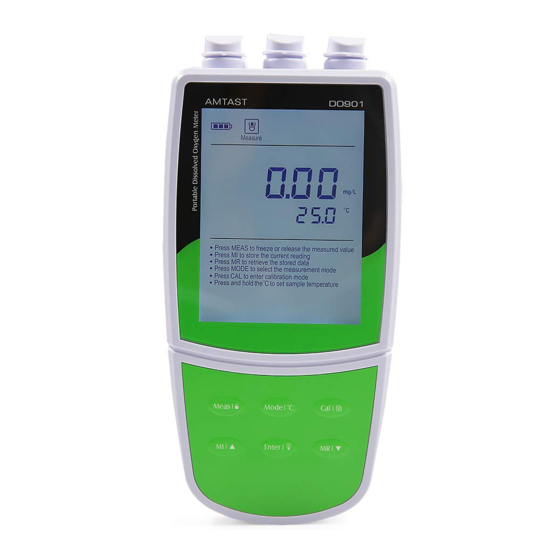
Subscribe to Our Youtube Channel
Summary of Contents for AMTAST DO901
- Page 1 AMTAST Portable Dissolved Oxygen Meter DO901 Instruction Manual AMTAST USA INC AMTAST USA INC...
- Page 2 DO901 Portable Dissolved Oxygen Meter Introduction hank you for selecting the AMTAST portable dissolved oxygen meter . This manual provides a step-by-step guide to help you operate the meter, please carefully read the following instructions before use. Unpacking Before unpacking, ensure that the current work environment meets following conditions.
- Page 3 DO901 Portable Dissolved Oxygen Meter Display The AMTAST portable dissolved oxygen meter is equipped with an easy-read LCD display that used to show the measured values and mode icons. The following table describes the function of each icon. AMTAST DO901...
- Page 4 DO901 Portable Dissolved Oxygen Meter Keypad FUNCTION • Switches the meter ON/OFF. • Locks the measured value, press the key again to resume measuring. • Exits the calibration or setting and returns to measurement. • Toggles between % saturation and concentration measurement modes.
-
Page 5: Installing The Batteries
DO901 Portable Dissolved Oxygen Meter Installing the Batteries • Remove the battery cover from backside of the meter. • Insert three AA batteries into the battery compartment, note polarity. • Replace the battery cover into its original position. Installation is completed. -
Page 6: Connecting The Sensor
DO901 Portable Dissolved Oxygen Meter Connecting the Sensor Insert the 6-pin connector of the dissolved oxygen probe into the corresponding connector socket on meter. Ensure the connector is fully seated. After connection is completed, DO NOT pull on the sensor cord. Always make sure that the connector is clean and dry. -
Page 7: Setup Menu
DO901 Portable Dissolved Oxygen Meter Setup Menu The AMTAST dissolved oxygen meter contains an integrated setup menu that is used to customize the displayed option to meet measurement requirements. The following table describes the functions of the menu items. MENU... - Page 8 DO901 Portable Dissolved Oxygen Meter Setting the barometric pressure The following table describes the relationship between altitude and barometric pressure. Prior to the calibration or measurement, you need to set the compatible parameter according to the local altitude. ALTITUDE (m)
- Page 9 DO901 Portable Dissolved Oxygen Meter Setting the salinity coefficient Salt dissolved in water will influences oxygen content of water. If your sample belong to high concentration liquids, please make sure that you have selected an applicable salinity coefficient before measurement. For the low concentration liquids, please use the default coefficient 0.0 ppt.
- Page 10 DO Calibration in % Saturation Mode The AMTAST dissolved oxygen meter is able to perform either 1 or 2 points calibration. For single point calibration, we recommend that you perform 100% saturation calibration in the air-saturated water. If the 2 points calibration is selected, the zero oxygen solution needs to be used.
- Page 11 DO901 Portable Dissolved Oxygen Meter DO Calibration in mg/L or ppm Mode Single point calibration - air-saturated water Ensure that the meter shows measurement unit “ and you have selected 1 point calibration in the setup menu. Press the key, the meter mg/L”...
-
Page 12: Temperature Calibration
DO901 Portable Dissolved Oxygen Meter Temperature Calibration During the measurement process, if the temperature reading displayed differs from that of an accurate thermometer, the meter needs to be calibrated. Press and hold the key for 3 seconds to enter the temperature calibration mode. -
Page 13: Dissolved Oxygen Measurement
Dissolved Oxygen Measurement The AMTAST portable dissolved oxygen meter is suitable for measuring the water, wastewater, brine and other liquids. If the sample is belong to the seawater or other water containing large amounts of salt, please setting the salinity coefficient before measurement. Some gas and steam such as chloride, sulfur dioxide, sulfureted hydrogen, ammonium, carbon dioxide and iodin can permeate the membrane via diffusion. -
Page 14: Storing And Recalling Data
DO901 Portable Dissolved Oxygen Meter Storing and Recalling Data The AMTAST portable dissolved oxygen meter is capable of storing and recalling up to 100 data sets. Storing readings into memory During the measurement process, press the key to store the reading into the memory, the Memory icon appears on the display. -
Page 15: Electrode Care And Maintenance
DO901 Portable Dissolved Oxygen Meter Electrode Care and Maintenance • Always keep the membrane of the dissolved oxygen probe is wet or moist. • If you do not use the probe for long periods, please screw off membrane cap and rinse the cathode, anode and membrane with deionized water, then soak up residual water on them with filter pape. - Page 16 DO901 Portable Dissolved Oxygen Meter Addendum 1: Preparation of the zero oxygen solution Dissolve 500mg of sodium sulfate (Na ) reagent and a small amount of cobalt(II) chloride hexahydrate (CoCl • 6H O) in the 250mL distilled water, mix the solution until the reagent is completely dissolved.
- Page 17 Data Acquisition System Instruction Manual Download at www.amtast.com/soft/do901.rar Thank you for using the DAS data acquisition system. This software is used to transfer data, receive the measuring values or import the data to Excel. Before installation, ensure that Windows 7/8/10 operating system has been installed on your computer.
-
Page 18: Warranty
Hazardous Substance Statement AMTAST USA INC is committed to the reduction and eventual elimination of all hazardous substances in both the manufacturing process and finished products we supply. We have an active manufacturing and procurement program to minimize and eliminate the use of harmful heavy metals such as cadmium, lead, mercury and the like.









Need help?
Do you have a question about the DO901 and is the answer not in the manual?
Questions and answers